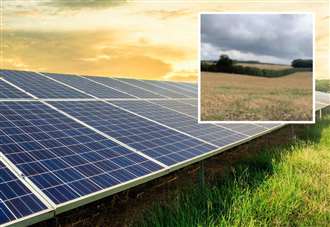Plans to build a solar farm the size of 106 football pitches near land earmarked for a huge housing development have been recommended for approval.
The panels would be on farmland around Pitstock Farm in Rodmersham, near Sittingbourne, for the next four decades if given the green light by Swale council.

It is claimed it would produce 41 megawatts (MW) of renewable energy per year, saving a minimum of 6,250 tonnes of CO2 per annum – the equivalent of taking 3,750 cars off the road or powering 14,500 homes every year.
Voltalia UK Ltd submitted proposals for its project in February 2024.
A firm spokesman said: “This is not just about generating clean homegrown energy to power British homes and businesses.
“It’s also about supporting our farmers to diversify so that they can invest in new farming equipment and secure the long-term future of farming across their wider landholdings.”
But four parish councils and almost 40 people have objected to the scheme.

Some of these opponents pointed to it being constructed near the planned Highsted Park development, which includes 8,400 homes.
That scheme is split into two applications, with the south site having 7,150 homes, community space, a hotel, a recycling centre, and primary and secondary schools.
This part of the proposal would sit near the solar farm if both are given the go-ahead.
The Highsted Park plans are being heard at a public inquiry that began in March and is to resume in October following an extension.
This was after being “called in” by the Secretary of State for Housing, Angela Rayner, at the “eleventh hour”, taking away the decision from Swale council, which was going to refuse the plans.

Other objections to the solar farm are from Tonge, Bapchild, Milstead and Rodmersham parish councils.
They argue that it should not be built due to the effect the “glint and glare” from the panels would have on properties nearby, its location on agricultural land and the fact HGVs will not be able to access the site due to the road network.
But Swale council’s own officers have recommended that its planning committee approve the plans.
A decision had been expected at a meeting this evening, but it was pulled from the agenda yesterday (Wednesday).
In a notification sent to councillors, Swale council said it had been removed “to enable further assessment of a matter that has been raised within a representation that was received after the publication of the report”.
KentOnline has asked the authority for further information.

The authority rejected plans for a different solar farm in Borden, which had been recommended for approval in August last year.
Industria Solar Vigo Ltd’s scheme, which would have been built off the M2 near the hamlet of Oad Street, was smaller than the scheme for Rodmersham, at the size of 86 football pitches.
It would have produced enough power for 11,500 homes.
But councillors blocked the plans, saying, “It isn’t an industrial landscape, it’s the Garden of England”.
Despite this, Voltalia UK Ltd says it “welcomes” the council’s conclusion that its plans align with Swale’s overall development plan.

The spokesman added: “For years, we have worked hard to engage constructively with all stakeholders.
“We have listened to feedback where we can and have made substantial design changes to make sure that, from heritage to highways, the technical details are right.
“Solar farms cannot be located anywhere, and we believe that our plan is the right proposal in the right place.
“The site is well screened and we will be planting over 1,000 new trees and bringing over five kilometres of hedgerow into management to create a green buffer full of new habitats for wildlife.
“We have a grid connection ready to go so that this project can make an immediate contribution to Britain’s energy security, economy and response to the climate crisis.
Find out about planning applications that affect you by visiting the Public Notice Portal
“After we have just experienced the driest spring for 69 years, it has never been more important for us to address the threat that climate change poses to the future of UK farming.”
The farm would have a life span of approximately 40 years. It would then be decommissioned and the land would be returned to its existing condition.
If approved, construction will take around six and a half months.
Some 70 workers will be required on site every day, as well as six HGVs. It is expected to produce four full-time jobs once completed.
